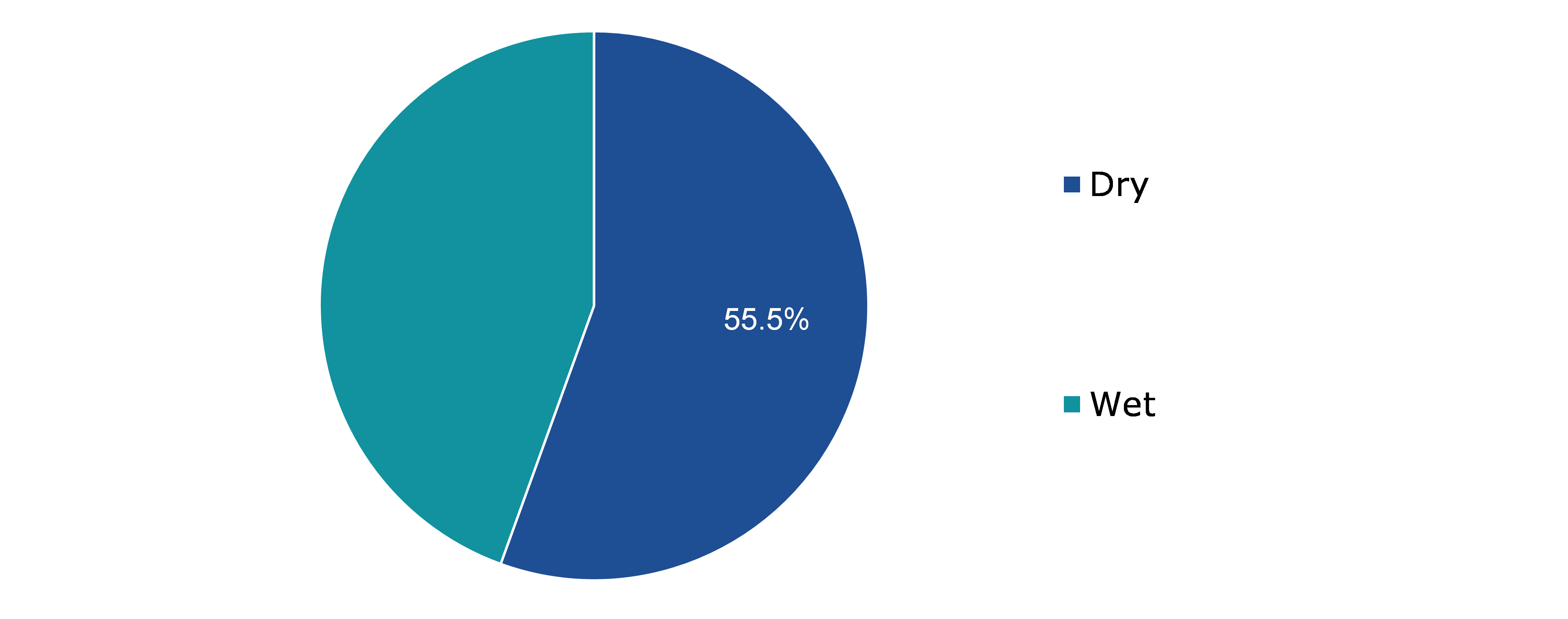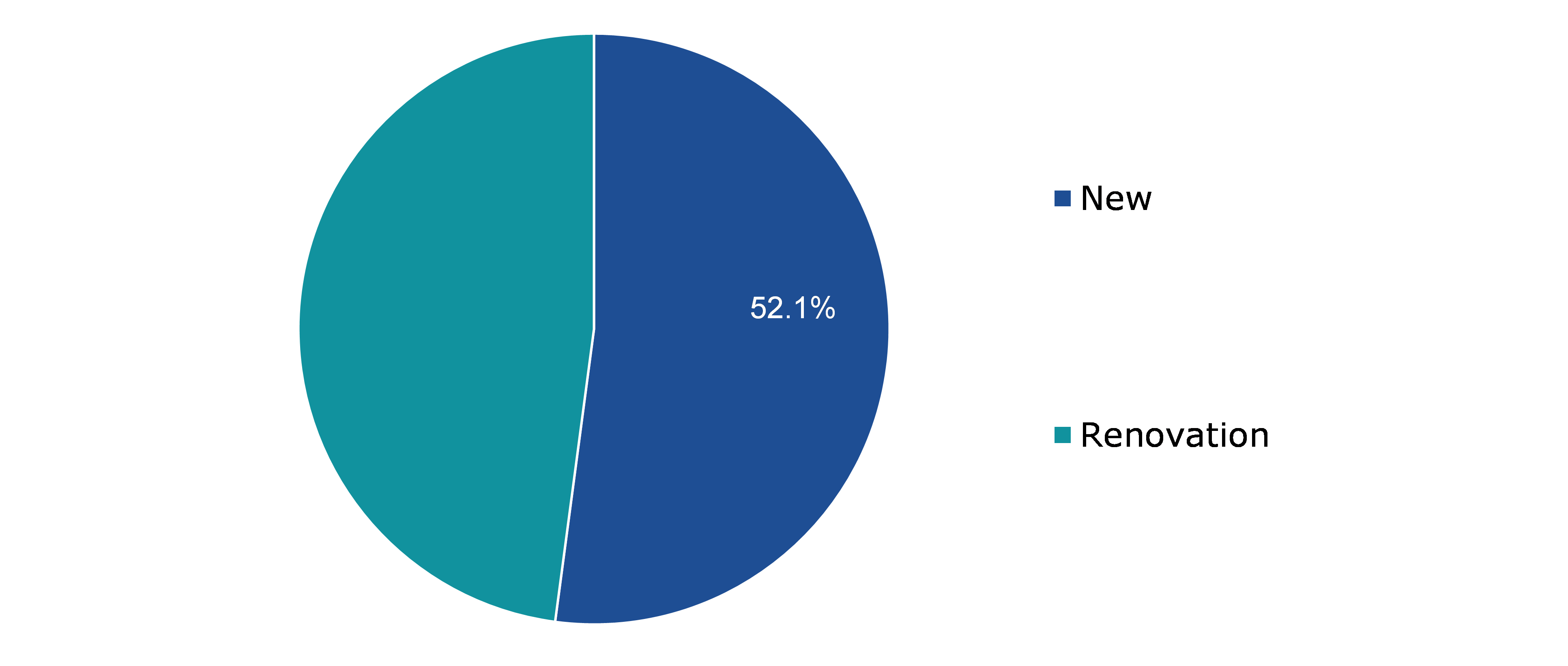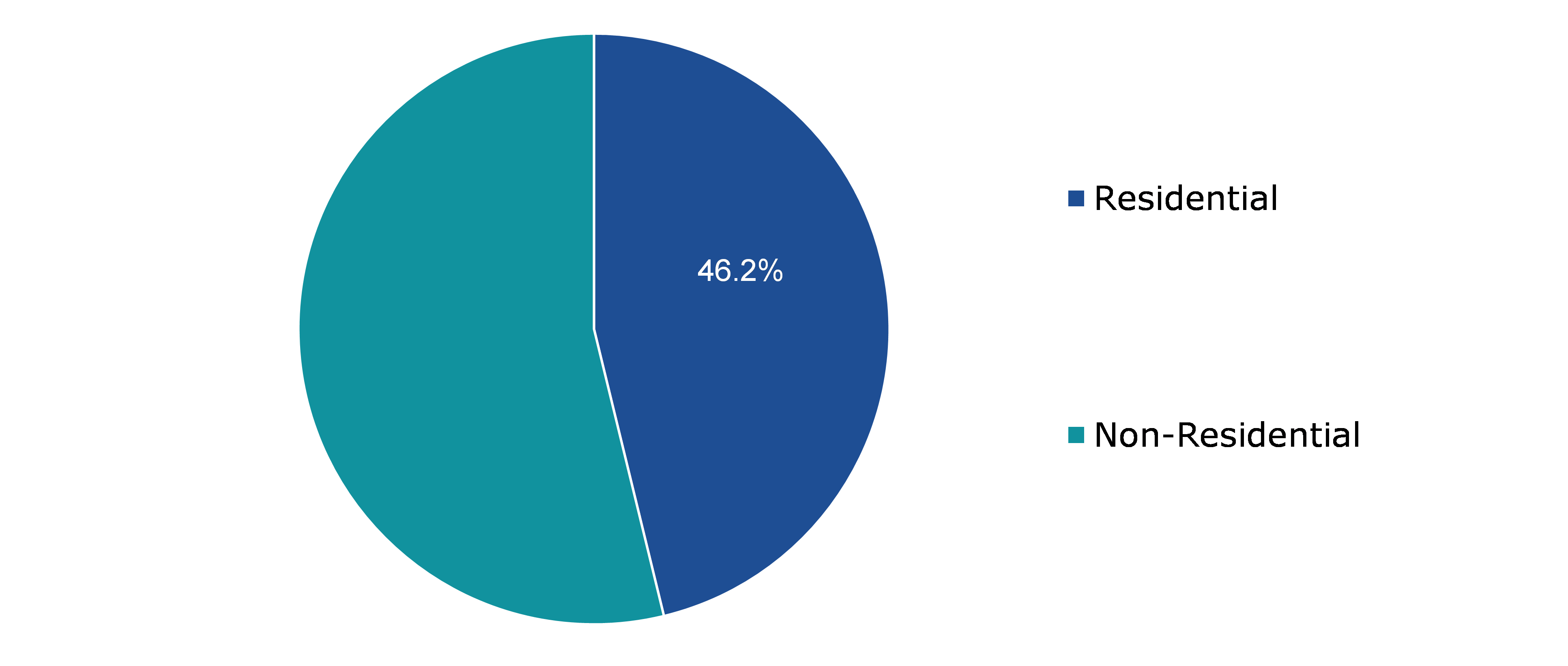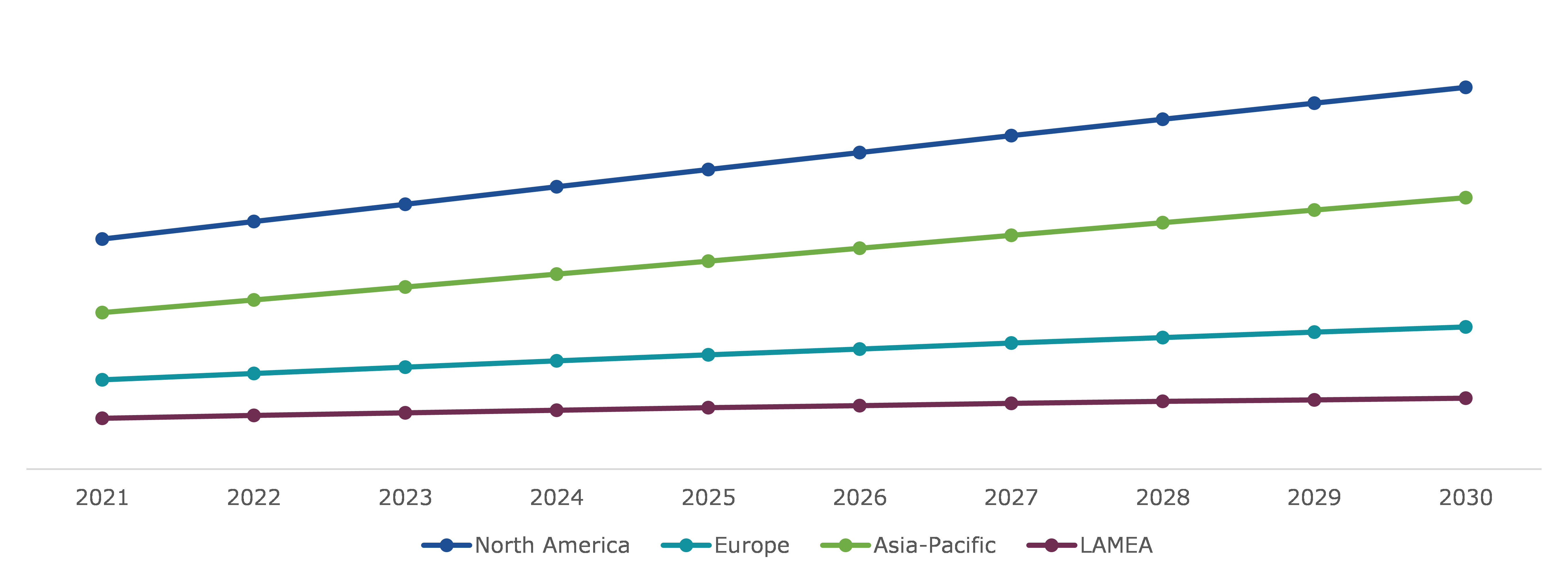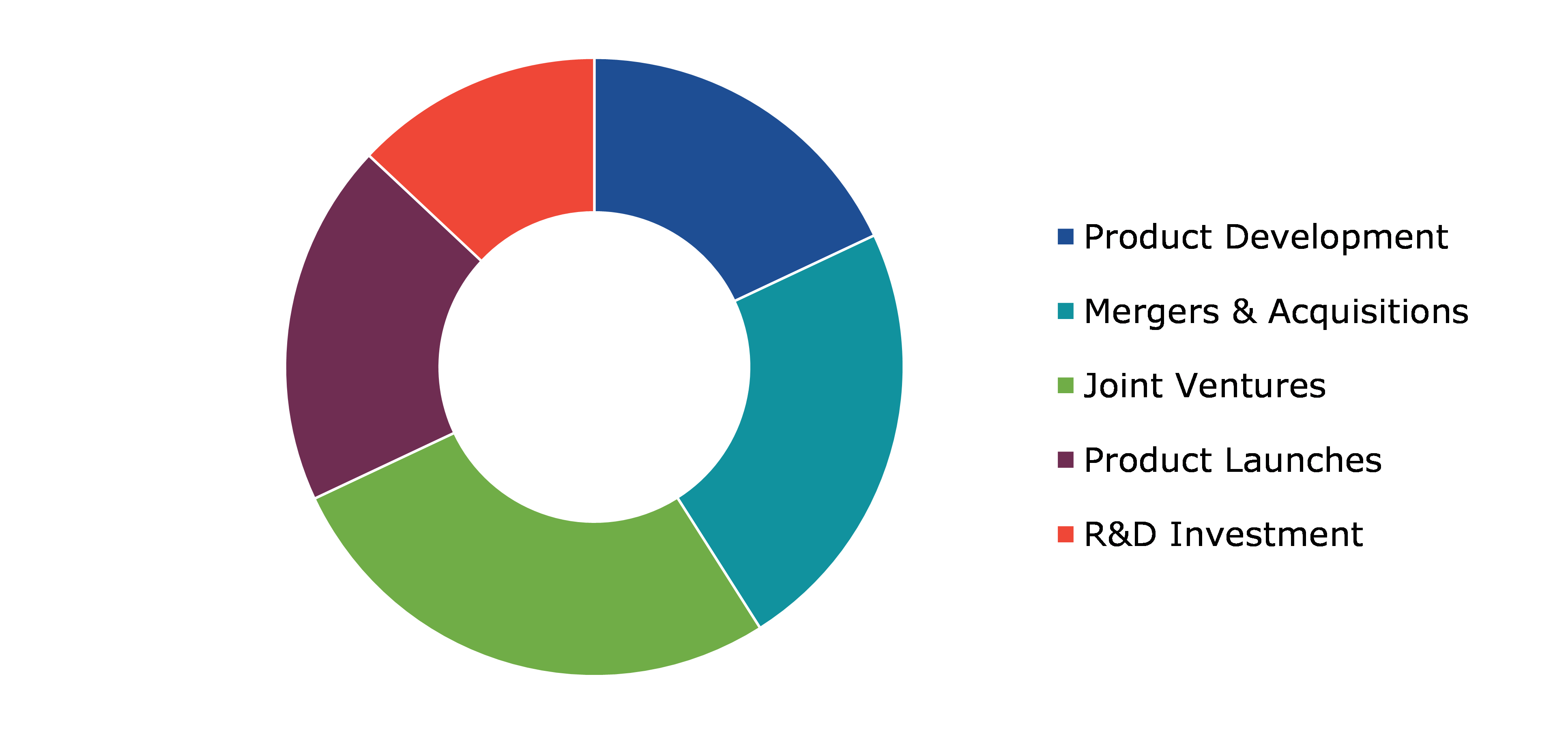Concrete Conditioner Market Report
RA08556
Concrete Conditioner Market by Method (Dry and Wet), Construction Type (New and Renovation), End-use (Residential and Non-residential), and Regional Analysis (North America, Europe, Asia-Pacific, and LAMEA): Global Opportunity Analysis and Industry Forecast, 2022–2030
Global Concrete Conditioner Market Analysis
The global concrete conditioner market size was $476 million in 2021 and is predicted to grow with a CAGR of 5.5%, by generating a revenue of $783 million by 2030.
Global Concrete Conditioner Market Synopsis
The concrete conditioner is a concrete purifier and conditioner designed for preservation of hardened polished concrete surfaces. This product is particularly concentrated and carries ultra-modern wetting and emulsifying agents. Demand for polished concrete in construction of hotel floors and industrial homes is exponentially boosting at an excessive rate. The advantages of polished concrete include resistance to skidding on the ground due to suitable friction, classy appearance of the ground, and resistance towards heavy footfall.
The primary restraint to the global concrete marketplace is expenses of raw material utilized in production of polished concrete conditioner market which fluctuates and hampers revenue growth of concrete conditioner market and this rate instability is expected to continue during the forecast period. Cement is a main element of concrete which has its very own environmental impacts. The cement industry produces carbon dioxide in excess which in large part contributes to global warming as it is a greenhouse gas.
Major concrete conditioner market players generally tend to make investments in the concrete conditioner market because this market has high growth possibilities for the future of remodeling and renovation of nonresidential locations. Concrete conditioner will help to provide aesthetic ambience to the infrastructure. Hotel and accommodation proprietors generally prefer to make the infrastructure as appealing as possible due to the fact that it draws huge customer base as customer gives wealthy reviews of lodging which aids the enterprise to hold the customers. These factors are expected to drive revenue growth of the concrete conditioner market over the forecasted years.
According to regional analysis, the Asia-Pacific concrete conditioner market accounted for $141.5 million in 2021 and is predicted to grow with a CAGR of 6.1% in the projected timeframe. Due to its increasing use in residential, commercial and industrial construction activities which is predicted to drive revenue growth of the concrete conditioner market.
Concrete Conditioner Overview
Concrete is a material made up of strong, chemically inert materials such as sand and gravel that are held together by cement and water. Portland cement is a mixture of limestone and clay that is used as the primary cementing agent in concrete manufacturing. Concrete conditioner is a concrete cleaner and conditioner intended to be used on polished concrete surfaces that have been hardened. Concrete conditioner products are extremely concentrated and advanced which include wetting and emulsifying ingredients.
COVID-19 Impact on Global Concrete Conditioner Market
The global concrete conditioner market has experienced a huge negative impact on the growth of industry due to the COVID-19 pandemic. There has been a negative impact because of the lack of supply chain infrastructure, lack of availability of labor, shortage of raw materials, and others. There have been restrictions imposed by governments of various countries across the globe where people were supposed to stay inside the house owing to which all the ongoing construction projects ceased and new projects procrastinated. There has been an increase in demand for concrete conditioner due to relaxation in COVID-19 restrictions. The concrete conditioner market is experiencing growth as infrastructural development is in a continuous need for advancement.
Increase Demand for Polished Concrete Drives the Growth of Concrete Conditioner Market
The primary factor that results in driving growth of concrete conditioner market is due to demand for polished concrete in construction of hotel flooring and commercial buildings. There are manifold benefits of polished concrete such as resistance to skidding on the floor due to appropriate friction, the aesthetic look of the floor, and resistance towards heavy footfall which causes wear and tear of the floor. It is projected that the demand will rise in Asia-Pacific and Middle East & Africa. Demand for polished concrete is expected to exponentially rise due to high investments in housing developments and fast industrialization in the developing countries of these regions. The aesthetic look leads to better ambience which shows the superiority of the facility and these factors drive demand for polished concrete over the forecasted years. Innovation and advancement of concrete condition products will be the main growth driver of the concrete conditioner market for the forecasting years. Change in concrete conditioner market dynamics influenced by major market players will influence new opportunities such as acquisitions and mergers.
Volatility in the Prices of Raw Materials to Restrain the Concrete Conditioner Market Growth
Prices of raw materials used in manufacturing polished concrete conditioner market fluctuates to a greater extent which is projected to hamper revenue growth of the concrete conditioner market and this price instability is estimated to continue in the forecast period. Fluctuation in the price of petroleum and crude oil may affect the price of concrete conditioner as the price of cement, adhesive, and sealants used in polished concrete will also get affected. Therefore the price of raw materials directly influences cost of polished concrete, increase in price of raw materials leads to increase in the price of products and reduction in the profit margins, such frequent changes are expected to hamper revenue growth of market during the forecasting years.
Cement is a major element of concrete which has its own environmental impacts. The cement industry produces carbon dioxide abundantly which majorly leads to global warming as it is a greenhouse gas. According to analysis, production of Portland cement accounts for approximately 5% of the anthropogenic CO2 emissions worldwide and about 2% of total CO2 emissions in the U.S.
Increase in the Renovation and Remodeling Enhances the Growth of Concrete Conditioner Market Globally
Remodeling and renovation of nonresidential places is predicted to boost demand for polished concrete as it will give aesthetic ambience which will further appeal to people’s desire of attaining similar infrastructure to their spaces. Hotels and resorts’ owners tend to make the infrastructure as attractive as possible because this attracts large clientele as customers get rich experience of accommodation which aids the business to retain the customers. For instance, in September 2019, JW Marriot opened a new hotel in Australia with latest design accents and polished concrete flooring which was visually attractive. Increasing investments from market players in the retail sector and residential construction is forecasted to further drive adoption of polished concrete which will help the market to grow exponentially.
To know more about global concrete conditioner market opportunities, get in touch with our analysts here.
Global Concrete Conditioner Market, by Method
On the basis of method, the market has been sub-segmented into dry and wet. Among the mentioned sub-segments, the wet sub-segment is predicted to show the fastest growth, whereas the dry sub-segment is projected to garner a significant market share.
Global Concrete Conditioner Market Share, by Method, 2021
Source: Research Dive Analysis
The dry sub-segment is estimated to have dominating market share in the global market and is expected to generate a revenue of $423.3 million by 2030, growing from $264.3 million in 2021. The dry concrete conditioner uses dust extraction system which is certified with HEPA (High Efficiency Particulate Air) filters. This protects the employees operating in dry concrete conditioner process from hazardous respirable silica dust therefore this method guarantees safe environment. Comparing the dry concrete conditioner methods with wet method, dry conditioner method endure more shine and finish. The dry method is suited in both small areas and large open spaces also it more cost effective. These factors may propel the generation of revenue and increase the growth of dry sub-segment throughout the forecasting period.
The wet sub-segment is projected to have the fastest growth and surpass $359.7 million by 2030, growing from $211.7 million in 2021. The rise is largely attributable to reduced downtime and employment of environment friendly propane fueled instruments and equipment which carry out 100% dust free procedure. The above-mentioned factors are likely to drive the wet sub-segment throughout the predicted period.
Global Concrete Conditioner Market, by Construction Type
Based on construction type, the market has been divided into new and renovation. Among these, the renovation sub-segment is predicted to have the fastest growth and the new Construction sub-segment is anticipated to garner the maximum revenue share in the global market.
Global Concrete Conditioner Market Share, by Construction Type, 2021
Source: Research Dive Analysis
The new sub-segment is anticipated to have a dominant market share and generate a revenue of $396.4 million by 2030, growing from $248 million in 2021. Demand for concrete conditioner is expected to increase exponentially due to rapid urbanization, investment in development of smart cities, and migration of people to urban areas, which drives growth of new construction activities. The new construction activities include construction of residential and commercial spaces around the world. This growth is majorly due to increasing number of new construction projects involving residential projects, warehouses, office spaces, and others. These factors are increasing speed at which the new construction sub-segment is growing, which eventually will pump revenue growth of concrete conditioner market over the forecasting years.
Global Concrete Conditioner Market, by End-use
Based on end-use, the market has been divided into residential and non-residential. Among these, the residential sub-segment is predicted to have the fastest growth and non-residential sub-segment is predicted to garner a significant revenue share in the global market.
Global Concrete Conditioner Market Share, by End-use, 2021
Source: Research Dive Analysis
The non-residential sub-segment is anticipated to have a dominant market share and generate a revenue of $403.6 million by 2030, growing from $256.1 million in 2021. There is an expeditious construction of hospitals, commercial complexes, hotels, industrial buildings and others due to which the concrete conditioner market is encountering an exponential demand from non-residential sub-segment. Since concrete conditioner is eco-friendly as there is no hazardous impact on indoor air quality or the environment, use of concrete conditioner for building of non-residential spaces like industrial or commercial construction aids the contractor to achieve the LEED (Leadership in Energy and Environmental Design) ratings which is a program for efficiently and environment friendly construction. The investment on construction industry is rapidly accelerating on non-residential construction and is estimated to further increase bullishly. All these factors are estimated to rapidly propel the growth of concrete conditioner market in the forecasted years.
Global Concrete Conditioner Market, Regional Insights
The global concrete conditioner market was investigated across Asia-Pacific, North America, Europe, and LAMEA.
Concrete Conditioner Market & Forecast, by Region, 2021-2030 (USD Million)
Source: Research Dive Analysis
The Market for Concrete Conditioner in Asia-Pacific to be the Most Dominant
The Asia-Pacific concrete conditioner market accounted $141.5 million in 2021 and is projected to grow with a CAGR of 6.1%. There has been an increase in residential, commercial, and industrial construction activities, which propels revenue growth of concrete conditioner market in the Asia-Pacific region. The rise in financial sector, economic stability, and government regulations on the CO2 emissions and other harmful gases which are harmful to the environment is expected to increase demand for concrete conditioners.
Competitive Scenario in the Global Concrete Conditioner Market
Investment and agreement are common strategies followed by major market players. For instance, on April 29, 2022, 3M valley expanded operations to Nebraska, invested around $58 million to fund the 80,000 square foot expansion that will create around 50 new jobs at the facility. The investment will allow 3M to expand production of 3M respiratory and hearing protection products.
Source: Research Dive Analysis
Some of the leading concrete conditioner market players are Pittsburgh Plate Glass Industries, Inc., 3M, BASF SE, Sika AG, Ultra Tech Cement Limited, The Sherwin Williams Company, Boral Limited, Solomon Colors Inc., Vexcon Chemicals Inc., and The Euclid Chemical Company.
| Aspect | Particulars |
| Historical Market Estimations | 2020–2021 |
| Base Year for Market Estimation | 2021 |
| Forecast Timeline for Market Projection | 2022–2030 |
| Geographical Scope | North America, Europe, LAMEA, and Asia-Pacific |
| Segment by Method |
|
| Segment by Construction |
|
| Segmentation by End-use |
|
| Companies covered |
|
Q1. What is the size of the global concrete conditioner market?
A. The size of the global concrete conditioner market was over $476 million in 2021 and is projected to reach $783 million by 2030.
Q2. Which are the major companies in the concrete conditioner market?
A. Pittsburgh Plate Glass Industries, Inc., 3M, BASF SE, Sika AG, Ultra Tech Cement Limited, The Sherwin Williams Company, Boral Limited, Solomon Colors Inc., Vexcon Chemicals Inc., and The Euclid Chemical Company are the major companies in the concrete conditioner market.
Q3. Which region, among others, possesses greater investment opportunities in the near future?
A. The Asia-Pacific region possesses great investment opportunities for investors to witness the most promising growth in the future.
Q4. What will be the growth rate of the Asia-Pacific concrete conditioner market?
A. Asia-Pacific concrete conditioner market is anticipated to grow at 6.1% CAGR during the forecast period.
Q5. What are the strategies opted by the leading players in this market?
A. Agreement and investment are the two key strategies opted by the operating companies in this market.
Q6. Which companies are investing more on R&D practices?
A. Sika and BASF SE are the companies investing more on R&D activities for developing new products and technologies.
1.Research Methodology
1.1.Desk Research
1.2.Real time insights and validation
1.3.Forecast model
1.4.Assumptions and forecast parameters
1.5.Market size estimation
1.5.1.Top-down approach
1.5.2.Bottom-up approach
2.Report Scope
2.1.Market definition
2.2.Key objectives of the study
2.3.Report overview
2.4.Market segmentation
2.5.Overview of the impact of COVID-19 on Global concrete conditioner market
3.Executive Summary
4.Market Overview
4.1.Introduction
4.2.Growth impact forces
4.2.1.Drivers
4.2.2.Restraints
4.2.3.Opportunities
4.3.Market value chain analysis
4.3.1.List of raw material suppliers
4.3.2.List of manufacturers
4.3.3.List of distributors
4.4.Innovation & sustainability matrices
4.4.1.Technology matrix
4.4.2.Regulatory matrix
4.5.Porter’s five forces analysis
4.5.1.Bargaining power of suppliers
4.5.2.Bargaining power of consumers
4.5.3.Threat of substitutes
4.5.4.Threat of new entrants
4.5.5.Competitive rivalry intensity
4.6.PESTLE analysis
4.6.1.Political
4.6.2.Economical
4.6.3.Social
4.6.4.Technological
4.6.5.Environmental
4.7.Impact of COVID-19 on concrete conditioner market
4.7.1.Pre-covid market scenario
4.7.2.Post-covid market scenario
5.Concrete Conditioner Market Analysis, by Method
5.1.Overview
5.2.Dry
5.2.1.Definition, key trends, growth factors, and opportunities, 2021-2030
5.2.2.Market size analysis, by region, 2021-2030
5.2.3.Market share analysis, by country, 2021-2030
5.3.Wet
5.3.1.Definition, key trends, growth factors, and opportunities, 2021-2030
5.3.2.Market size analysis, by region, 2021-2030
5.3.3.Market share analysis, by country, 2021-2030
5.4.Research Dive Exclusive Insights
5.4.1.Market attractiveness, 2021-2030
5.4.2.Competition heatmap, 2021-2030
6.Concrete Conditioner Market Analysis, by Construction Type
6.1.New
6.1.1.Definition, key trends, growth factors, and opportunities, 2021-2030
6.1.2.Market size analysis, by region, 2021-2030
6.1.3.Market share analysis, by country, 2021-2030
6.2.Renovation
6.2.1.Definition, key trends, growth factors, and opportunities, 2021-2030
6.2.2.Market size analysis, by region, 2021-2030
6.2.3.Market share analysis, by country, 2021-2030
6.3.Research Dive Exclusive Insights
6.3.1.Market attractiveness, 2021-2030
6.3.2.Competition heatmap, 2021-2030
7.Concrete Conditioner Market Analysis, by End-use
7.1.Residential
7.1.1.Definition, key trends, growth factors, and opportunities, 2021-2030
7.1.2.Market size analysis, by region, 2021-2030
7.1.3.Market share analysis, by country, 2021-2030
7.2.Non-residential
7.2.1.Definition, key trends, growth factors, and opportunities, 2021-2030
7.2.2.Market size analysis, by region, 2021-2030
7.2.3.Market share analysis, by country, 2021-2030
7.3.Research Dive Exclusive Insights
7.3.1.Market attractiveness, 2021-2030
7.3.2.Competition heatmap, 2021-2030
8.Concrete Conditioner Market Analysis, by Region
8.1.North America
8.1.1.U.S.
8.1.1.1.Market size analysis, by Method, 2021-2030
8.1.1.2.Market size analysis, by Construction, 2021-2030
8.1.1.3.Market size analysis, by End-use, 2021-2030
8.1.2.Canada
8.1.2.1.Market size analysis, by Method, 2021-2030
8.1.2.2.Market size analysis, by Construction, 2021-2030
8.1.2.3.Market size analysis, by End-use, 2021-2030
8.1.3.Mexico
8.1.3.1.Market size analysis, by Method, 2021-2030
8.1.3.2.Market size analysis, by Construction, 2021-2030
8.1.3.3.Market size analysis, by End-use, 2021-2030
8.1.4.Research Dive Exclusive Insights
8.1.4.1.Market attractiveness, 2021-2030
8.1.4.2.Competition heatmap, 2021-2030
8.2.Europe
8.2.1.Germany
8.2.1.1.Market size analysis, by Method, 2021-2030
8.2.1.2.Market size analysis, by Construction, 2021-2030
8.2.1.3.Market size analysis, by End-use, 2021-2030
8.2.2.U.K.
8.2.2.1.Market size analysis, by Method, 2021-2030
8.2.2.2.Market size analysis, by Construction, 2021-2030
8.2.2.3.Market size analysis, by End-use, 2021-2030
8.2.3.France
8.2.3.1.Market size analysis, by Method, 2021-2030
8.2.3.2.Market size analysis, by Construction, 2021-2030
8.2.3.3.Market size analysis, by End-use, 2021-2030
8.2.4.Spain
8.2.4.1.Market size analysis, by Method, 2021-2030
8.2.4.2.Market size analysis, by Construction, 2021-2030
8.2.4.3.Market size analysis, by End-use, 2021-2030
8.2.5.Italy
8.2.5.1.Market size analysis, by Method, 2021-2030
8.2.5.2.Market size analysis, by Construction, 2021-2030
8.2.5.3.Market size analysis, by End-use, 2021-2030
8.2.6.Rest of Europe
8.2.6.1.Market size analysis, by Method, 2021-2030
8.2.6.2.Market size analysis, by Construction, 2021-2030
8.2.6.3.Market size analysis, by End-use, 2021-2030
8.2.7.Research Dive Exclusive Insights
8.2.7.1.Market attractiveness, 2021-2030
8.2.7.2.Competition heatmap, 2021-2030
8.3.Asia-Pacific
8.3.1.China
8.3.1.1.Market size analysis, by Method, 2021-2030
8.3.1.2.Market size analysis, by Construction, 2021-2030
8.3.1.3.Market size analysis, by End-use, 2021-2030
8.3.2.Japan
8.3.2.1.Market size analysis, by Method, 2021-2030
8.3.2.2.Market size analysis, by Construction, 2021-2030
8.3.2.3.Market size analysis, by End-use, 2021-2030
8.3.3.India
8.3.3.1.Market size analysis, by Method, 2021-2030
8.3.3.2.Market size analysis, by Construction, 2021-2030
8.3.3.3.Market size analysis, by End-use, 2021-2030
8.3.4.Australia
8.3.4.1.Market size analysis, by Method, 2021-2030
8.3.4.2.Market size analysis, by Construction, 2021-2030
8.3.4.3.Market size analysis, by End-use, 2021-2030
8.3.5.South Korea
8.3.5.1.Market size analysis, by Method, 2021-2030
8.3.5.2.Market size analysis, by Construction, 2021-2030
8.3.5.3.Market size analysis, by End-use, 2021-2030
8.3.6.Rest of Asia-Pacific
8.3.6.1.Market size analysis, by Method, 2021-2030
8.3.6.2.Market size analysis, by Construction, 2021-2030
8.3.6.3.Market size analysis, by End-use, 2021-2030
8.3.7.Research Dive Exclusive Insights
8.3.7.1.Market attractiveness, 2021-2030
8.3.7.2.Competition heatmap, 2021-2030
8.4.LAMEA
8.4.1.Brazil
8.4.1.1.Market size analysis, by Method, 2021-2030
8.4.1.2.Market size analysis, by Construction, 2021-2030
8.4.1.3.Market size analysis, by End-use, 2021-2030
8.4.2.Saudi Arabia
8.4.2.1.Market size analysis, by Method, 2021-2030
8.4.2.2.Market size analysis, by Construction, 2021-2030
8.4.2.3.Market size analysis, by End-use, 2021-2030
8.4.3.UAE
8.4.3.1.Market size analysis, by Method, 2021-2030
8.4.3.2.Market size analysis, by Construction, 2021-2030
8.4.3.3.Market size analysis, by End-use, 2021-2030
8.4.4.South Africa
8.4.4.1.Market size analysis, by Method, 2021-2030
8.4.4.2.Market size analysis, by Construction, 2021-2030
8.4.4.3.Market size analysis, by End-use, 2021-2030
8.4.5.Rest of LAMEA
8.4.5.1.Market size analysis, by Method, 2021-2030
8.4.5.2.Market size analysis, by Construction, 2021-2030
8.4.5.3.Market size analysis, by End-use, 2021-2030
8.4.6.Research Dive Exclusive Insights
8.4.6.1.Market attractiveness, 2021-2030
8.4.6.2.Competition heatmap, 2021-2030
9.Competitive Landscape
9.1.Top winning strategies, 2021
9.1.1.By strategy
9.1.2.By year
9.2.Strategic overview
9.3.Market share analysis, 2021
10.Company Profiles
10.1. Pittsburgh Plate Glass Industries, Inc.
10.1.1.Overview
10.1.2.Business segments
10.1.3.Product portfolio
10.1.4.Financial performance
10.1.5.Recent developments
10.1.6.SWOT analysis
10.2.3M
10.2.1.Overview
10.2.2.Business segments
10.2.3.Product portfolio
10.2.4.Financial performance
10.2.5.Recent developments
10.2.6.SWOT analysis
10.3.BASF SE
10.3.1.Overview
10.3.2.Business segments
10.3.3.Product portfolio
10.3.4.Financial performance
10.3.5.Recent developments
10.3.6.SWOT analysis
10.4. Sika AG
10.4.1.Overview
10.4.2.Business segments
10.4.3.Product portfolio
10.4.4.Financial performance
10.4.5.Recent developments
10.4.6.SWOT analysis
10.5.The Sherwin-Williams Company
10.5.1.Overview
10.5.2.Business segments
10.5.3.Product portfolio
10.5.4.Financial performance
10.5.5.Recent developments
10.5.6.SWOT analysis
10.6.UltraTech Cement Limited
10.6.1.Overview
10.6.2.Business segments
10.6.3.Product portfolio
10.6.4.Financial performance
10.6.5.Recent developments
10.6.6.SWOT analysis
10.7. Boral Limited
10.7.1.Overview
10.7.2.Business segments
10.7.3.Product portfolio
10.7.4.Financial performance
10.7.5.Recent developments
10.7.6.SWOT analysis
10.8.Solomon Colors Inc.
10.8.1.Overview
10.8.2.Business segments
10.8.3.Product portfolio
10.8.4.Financial performance
10.8.5.Recent developments
10.8.6.SWOT analysis
10.9.Vexcon Chemicals Inc.
10.9.1.Overview
10.9.2.Business segments
10.9.3.Product portfolio
10.9.4.Financial performance
10.9.5.Recent developments
10.9.6.SWOT analysis
10.10.The Euclid Chemical Company
10.10.1.Overview
10.10.2.Business segments
10.10.3.Product portfolio
10.10.4.Financial performance
10.10.5.Recent developments
10.10.6.SWOT analysis
11.Appendix
11.1.Parent & peer market analysis
11.2.Premium insights from industry experts
11.3.Related reports
The construction industry is evolving like never before in the current decade. With many other innovative products, technologies, and raw materials used in this industry, polished concrete is one of the products extensively used in commercial well as industrial rooms or floorings. Concrete conditioners are cleaners and conditioners for hard, polished concrete surfaces.
In the recent years, there has been an enormous demand for visually appealing infrastructures worldwide, owing to the appearance and worth that is depicted by the aspects of the commercial spaces. Especially, infrastructures like hotels use concrete conditioners with an aim to uphold the look and feel of the infrastructure and add & retain the customer base. Concrete conditioners offer stunning as well as lustrous appearance and avoid the wear & tear of the flooring. Growing population across the globe has propelled the demand for private residences globally. As a result, the demand for concrete conditioners in many high-profile projects has skyrocketed in the recent years. In addition, repair and overhaul activities of the prevailing housing as well as commercial projects are increasing owing to the augmented need for enhanced buildings with improved safety.
Newest Insights in the Concrete Conditioner Market
As per a report by Research Dive, the global concrete conditioner market is expected to hit a revenue of $783 million in the 2022–2031 timeframe. The Asia-Pacific concrete conditioner market is estimated to observe leading and speedy growth in the years to come. This is because, the region has an enormous demand for concrete conditioners owing to the growing residential, commercial, and industrial construction projects in the region. Additionally, rise in investments in residential developments in the Asia-Pacific and Middle East & Africa regions is projected to drive the growth of the concrete conditioner market in the coming years.
How are Market Players Retorting to the Rising Demand for Concrete Conditioners?
Market players are greatly investing in novel product launches to cater the rising demand for concrete conditioners. Some of the foremost players of the concrete conditioner market are Sika AG, Pittsburgh Plate Glass Industries, Inc., BASF SE, The Sherwin Williams Company, 3M, The Euclid Chemical Company, Boral Limited, Solomon Colors Inc., Ultra Tech Cement Limited, Vexcon Chemicals Inc., and others. These companies are involved in planning and devising strategies such as innovative product launches, collaborations, novel advances, mergers and acquisitions, and partnerships to hold a leading position in the global industry.
For instance,
- In July 2018, XL North, a company renowned for its commercial floor maintenance chemistry & technology, launched a novel division along with the roll out of 3 innovative concrete surface prep products.
- In April 2019, Tennant Coatings, a well-known forerunner in the production of industrial & commercial floor and wall coating products, launched novel ReVue™ Hydro Polishing product line for concrete floorings.
- In June 2022, Ameripolish, a frontrunner in the invention of concrete chemical technology, unveiled the SmartFloor™ Refinement System, a product that makes it easy to renovate polished concrete surfaces.
COVID-19 Impact on the Global Concrete Conditioner Market
The unexpected rise of the coronavirus pandemic in 2020 has unfavourably impacted the global concrete conditioner market. During the pandemic period, the cessation of several industries across the world and implementation of restrictions on the global trade of raw materials required in the manufacture of concrete conditioners have hindered the growth of the market. Moreover, the halt of construction projects has significantly deteriorated the demand for concrete conditioners, consequently plummeting their sales. However, as the global construction industry is undergoing V-shaped recovery post-pandemic, the concrete conditioners market is also estimated to boom in the coming years.
The development of economy, rise in construction activities, growth in the number of construction companies and developers worldwide has opened marvellous opportunities for the concrete conditioner market’s growth. To sum up, the global market is likely to boost significantly in the future years.
Personalize this research
- Triangulate with your own data
- Request your format and definition
- Get a deeper dive on a specific application, geography, customer or competitor
- + 1-888-961-4454 Toll - Free
- support@researchdive.com


